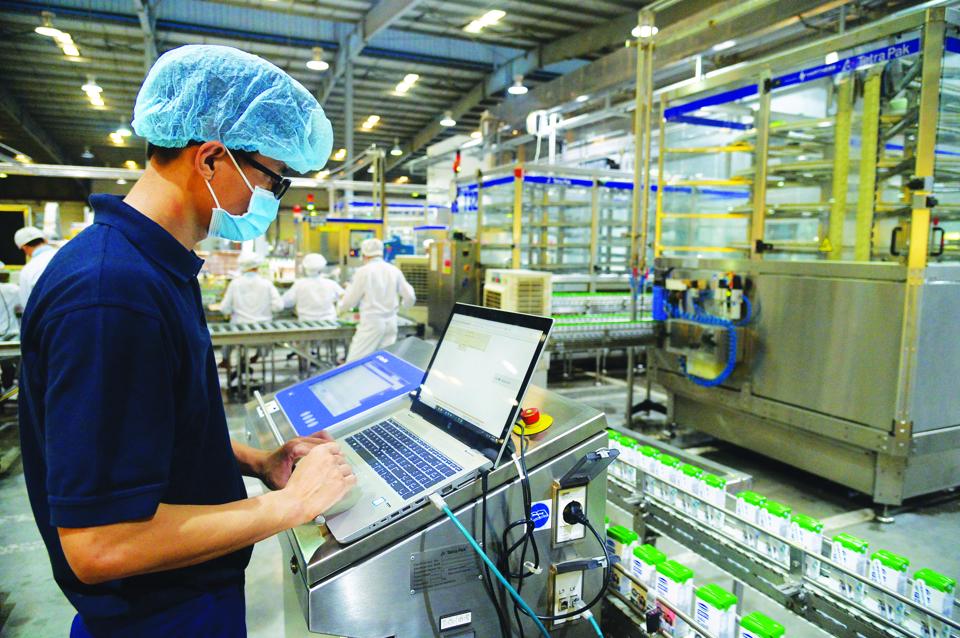Vietnam’s economic recovery remains strong despite heightened global uncertainties: WB
The Government should remain vigilant about inflation risks associated with rising prices of fuels and imports, which may dampen the ongoing recovery of domestic demand.
The economic recovery remained strong despite heightened global uncertainties related to the Russia-Ukraine conflict, higher commodity prices, and supply chain disruption caused by health-related lockdowns in China, according to the World Bank.
| Production at Yen Phong Industrial Park. Photo: Pham Hung/ The Hanoi Times |
In its latest macro report, World Bank noted major mobility indicators have fully recovered, adding visits to restaurants, coffee shops, shopping malls, and other retail and recreation establishments that have reached levels seen before the pandemic.
Meanwhile, the industrial production index increased by 10.4% year-on-year (y/y) in May, comparable to its pre-pandemic rates, including production expansion in beverage, apparel, footwear, and electronic products.
However, machinery manufacturing slowed down from 26.6% (y/y) in March to 6.1% in April and to only 3.7% in May. This deceleration could be related to supply chain disruptions and the shortage of imported inputs caused by the health-related lockdowns in China.
Imports of machinery dropped in the last three months compared to a year ago. The PMI manufacturing jumped from 51.7 in April to a 12-month high of 54.7 in May, which indicates a strengthening expansion in manufacturing.
Retail sales increased by a record 22.6% (y/y) in May, compared to the 12.7% rate in April. This acceleration is partly due to a low-base effect as sales had dropped by 2.1% in May 2021 following the fourth outbreak flaring up last April and subsequent mobility restrictions.
“To a larger extent, however, this growth in sales reflected the firming of domestic private consumption and the return of international tourists after the government opened the borders in late March 2022,” noted the report.
About 173,000 international visitors arrived in May, roughly 70% higher than in April and the highest figure since April 2020, yet still less than 15% of pre-pandemic levels. Sales of consumer services, which were hit harder than the sales of goods last year experienced a stronger rebound of 41% compared to 18.3% (y/y), respectively.
Travelling also tripled compared to a year ago although it was about 60% lower than its pre-pandemic level, stated the World Bank.
Credit growth supports economic recovery
The World Bank also pointed out that despite surging prices of gasoline and diesel in recent months, Vietnam’s consumer price index increased by 2.9% year on year but remained well below the 4% target.
In addition, credit to the economy grew by 16.9% (y/y) in May, comparable to the rates seen in the last few months and 1.5 percentage points higher than a year ago.
According to the World Bank, a strong economic recovery increased the demand for credit to finance business expansion and household consumption.
The Government launched a targeted, limited, and time-bound interest rate subsidy as part of the Economic Recovery Support Program 2022- 2023 announced in January 2022. The subsidy is targeted at specific sectors, including those that have been severely affected by the pandemic like transportation and storage, accommodation and food services, and travel support services. This support measure has an envelope of VND40 trillion or US$1.7 billion (or 0.5% of GDP) and is effective until the end of 2023.
Despite the positive economic performance, the World Bank urged the Government to remain vigilant to inflation risks associated with rising prices of fuels and imports, which may dampen the ongoing recovery of domestic demand.
Temporary support including targeted transfer should be considered to help poor households weather the surging fuel prices, it added.
“As the price shock is mainly affecting fuels with passthrough to costs of transportation, targeted temporary subsidy for main gasoline and fuel users (such as truckers) could also be considered to alleviate hardship and blunt the inflationary pressures,” noted the bank.
Also, the government could incentivize investment to help increase aggregate supply. Incentivizing alternative energy production and use would reduce the economy’s dependence on imported fuels and promote greener growth, it concluded.
Hanoi's GRDP in the first six months of 2022 is estimated at 7.79% year on year, a 1.29-fold increase against the same period of last year, while the city’s state budget collection increased by 20.2% year on year and reached 56.8% of the year’s estimate. This came as the fact that the Covid-19 pandemic in the city has gradually been contained, allowing the city to shift its focus toward socio-economic recovery. |












